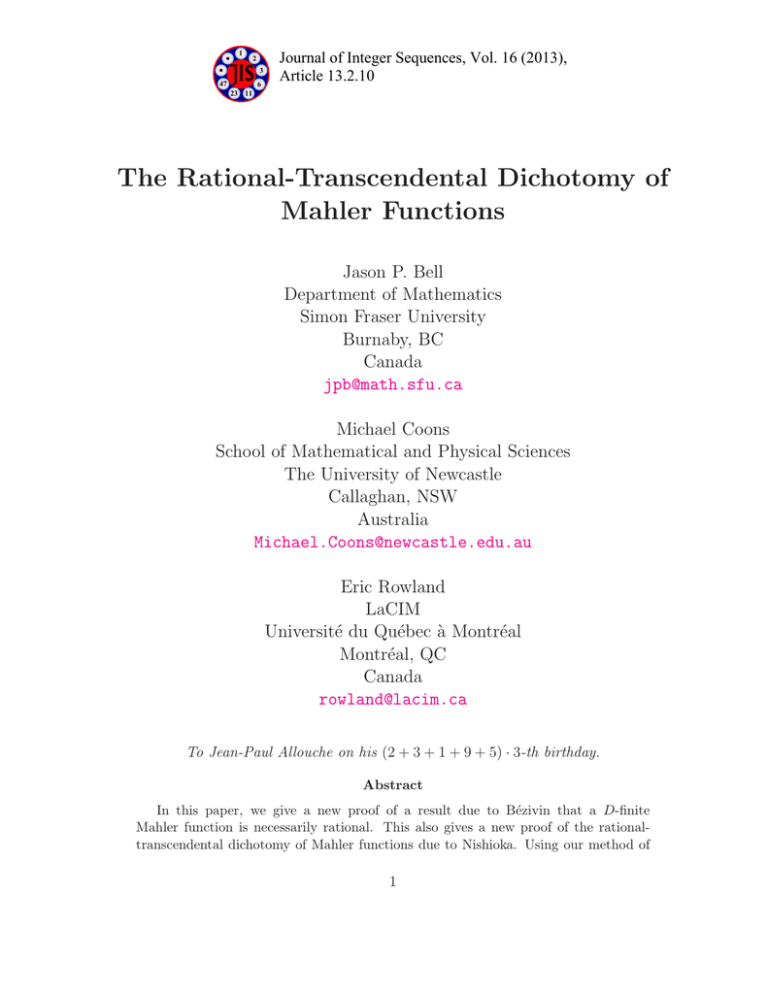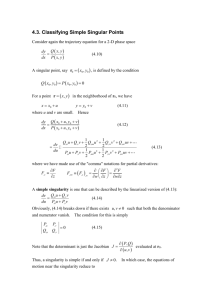The Rational-Transcendental Dichotomy of Mahler Functions
advertisement

1
2
3
47
6
Journal of Integer Sequences, Vol. 16 (2013),
Article 13.2.10
23 11
The Rational-Transcendental Dichotomy of
Mahler Functions
Jason P. Bell
Department of Mathematics
Simon Fraser University
Burnaby, BC
Canada
jpb@math.sfu.ca
Michael Coons
School of Mathematical and Physical Sciences
The University of Newcastle
Callaghan, NSW
Australia
Michael.Coons@newcastle.edu.au
Eric Rowland
LaCIM
Université du Québec à Montréal
Montréal, QC
Canada
rowland@lacim.ca
To Jean-Paul Allouche on his (2 + 3 + 1 + 9 + 5) · 3-th birthday.
Abstract
In this paper, we give a new proof of a result due to Bézivin that a D-finite
Mahler function is necessarily rational. This also gives a new proof of the rationaltranscendental dichotomy of Mahler functions due to Nishioka. Using our method of
1
proof, we also provide a new proof of a Pólya-Carlson type result for Mahler functions
due to Randé; that is, a Mahler function which is meromorphic in the unit disk is
either rational or has the unit circle as a natural boundary.
1
Introduction
The Thue-Morse sequence {t(n)}n≥0 over the alphabet {−1, 1} is given by t(n) = (−1)s(n)
where s(n) is the number of 1s in the base 2 expansion of the number n. Using this definition
it is immediate that the sequence {t(n)}n≥0 is 2-automatic. That is, there is a deterministic
finite automaton that takes the base 2 expansion of n as input and outputs the value t(n)
(see Figure 1); the definition of an automatic sequence will be discussed in more detail below.
✬✩ ✬✩
☛
✙
❘
✲
−1
1
0
1
0
1 ✯✫✪
✫✪
Figure 1: The generating 2-automaton of the Thue-Morse sequence.
It is also immediate using the definition that the Thue-Morse sequence is the unique sequence
given by t(0) = 1, t(2n) =
Pt(n) and t(2n + 1) = −t(n). Thus, writing the generating power
series for t(n) as T (z) = n≥0 t(n)z n , we have that T (z) satisfies the functional equation
(1 − z)T (z 2 ) = T (z).
The Thue-Morse number is the evaluation
P of the generating power series for {t(n)}n≥0 at
z = 1/2; that is, the number T (1/2) = n≥0 t(n)2−n . Due to the nature of the construction
of the Thue-Morse sequence and the functional equation satisfied by its generating power
series, the Thue-Morse number and those numbers with similar attributes are a natural
class of numbers to consider from the perspectives of transcendental number theory and
Diophantine approximation.
Focusing on the functional equation aspect, in the late 1920s and early 1930s, Mahler
[6, 7, 8] showed that if F (z) ∈ Q[[z]] satisfies
a(z)F (z k ) = b(z)F (z)
(1)
for some a(z), b(z) ∈ Q[z] and F (z) is transcendental over Q(z), then for all but finitely many
algebraic points α in radius of convergence of F (z), F (α) is transcendental over Q. One of
the main goals of Mahler’s above-cited work was to provide a proof of the transcendence
of the Thue-Morse number, a goal which Mahler accomplished [6]. Extensions of Mahler’s
work in this area have been, and are still, a vital area of research in number theory under the
heading Mahler’s method. In this paper, we are concerned with the following generalization
of (1).
2
Let k ≥ 2 be a positive integer. We say that a function F (z) ∈ C[[z]] is k-Mahler
(or sometimes just Mahler) provided there exist a non-negative integer d and polynomials
a0 (z), . . . , ad (z) ∈ C[z] with a0 (z)ad (z) 6= 0 such that
d
a0 (z)F (z) + a1 (z)F (z k ) + · · · + ad (z)F (z k ) = 0.
(2)
The functional equation in (2) is called a Mahler-type functional equation. Loxton and van
der Poorten [5] claimed an analogue of Mahler’s above-mentioned result for functions F (z) ∈
Z[[z]] satisfying (2), although their proof is not complete [2, remark following Corollary 2].
One may also wish to possibly avoid the functional equation approach and focus on
generalizing the automatic aspect inspired by the Thue-Morse sequence. While the definition
of automaticity based on computability by finite state automata is useful in a computational
setting, we will use an equivalent and combinatorial (or sequential) definition which is more
suitably generalized in a mathematical context. Let f := {f (n)}n≥0 be a sequence with
values in a ring R. We define the k-kernel of f to be the set
n
o
{f (k l n + r)}n≥0 : l ≥ 0 and 0 ≤ r < k l .
Given k ≥ 2, we say a sequence f is k-automatic if and only if the k-kernel of f is finite. Note
that by the definition, an automatic sequence can only take on a finite number of values.
To expand the notion of automatic sequences to sequences which can have values from an
infinite set, we take the following definition from Allouche and Shallit [1]. We say that a
sequence f taking values in a Z-module R is a k-regular sequence (or just k-regular) provided
there exist a finite number of sequences over R, say {f1 , . . . , fm }, with the property that
every sequence in the k-kernel of f is a Z-linear combination of the fi ; that is, f is k-regular
provided
P the k-kernel of f is contained in a finitely generated Z-module. We say that the
series n≥0 f (n)z n is k-regular (resp. k-automatic) when f is k-regular (resp. k-automatic).
Note that with these definitions in mind, it is easy to see that any k-automatic function is
also k-regular.
While the generalizations put forth in the preceding two paragraphs seem to branch into
unrelated territories, they are in fact closely related. Indeed, in 1994 Becker [2] showed that
a k-regular series is k-Mahler; this was previously known for k-automatic series [5]. Thus to
consider questions of transcendence of regular or automatic numbers, it may be enough to focus on Mahler’s method. In the application of Mahler’s method, as in the approach of Loxton
and van der Poorten [5], one must have in hand a transcendence result for the series F (z).
Fortunately, Nishioka [9, Theorem 5.1.7] established a rational-transcendental dichotomy
for solutions of certain systems of functional equations; in particular, a k-Mahler function
F (z) ∈ C[[z]] is either rational or transcendental. Also in 1994, Bézivin [3, Théorème 1-3]
provided an extension of the special case of Nishioka’s theorem to differentiably finite power
series. Recall that a function is said to be differentiably finite (or D-finite) if it satisfies a
homogeneous linear differential equation with polynomial coefficients [11].
Theorem 1 (Bézivin [3]). Let k ≥ 2 be an integer and F (z) ∈ C[[z]] be a k-Mahler function.
If F (z) is D-finite, then F (z) is a rational function.
Randé in his doctoral thesis [10] proved a Pólya-Carlson type theorem for Mahler functions. Unfortunately, Randé’s result has not appeared in the literature.
3
Theorem 2 (Randé [10]). Let k ≥ 2 be an integer and F (z) ∈ C[[z]] be a k-Mahler function.
Then F (z) is a rational function or it has the unit circle as a natural boundary.
In this paper, we provide new proofs of the theorems of Bézivin and Randé. These
theorems appear here in English for the first time. We note that the main ingredient of our
proofs of Theorems 1 and 2 is that a meromorphic k-Mahler function is necessarily rational.
2
Rational-transcendental dichotomy
We use the following result of Dumas [4, Theorem 31].
Theorem 3 (Structure Theorem of Dumas [4]). A k-Mahler function is the quotient of a
series and an infinite product which are k-regular and analytic in the unit disk. That is, if
F (z) is the solution of the Mahler functional equation
d
a0 (z)F (z) + a1 (z)F (z k ) + · · · + ad (z)F (z k ) = 0,
where a0 (z)ad (z) 6= 0, the ai (z) are polynomials, then there exists a k-regular series H(z)
such that
H(z)
F (z) = Q
,
kj
j≥0 Γ(z )
where a0 (z) = ρz δ0 Γ(z), with ρ 6= 0 and Γ(0) = 1.
Dumas’ theorem yields the following immediate corollary, which we note here as a lemma.
We denote the open ball of radius r > 0 centered at the origin by B(0, r).
Lemma 4. Let k ≥ 2 be an integer and let F (z) ∈ C[[z]] be a k-Mahler function. Then F (z)
has a positive radius of convergence.
Proof. Let k ≥ 2 be an integer and F (z) ∈ C[[z]] be a k-Mahler function satisfying, say,
d
X
j
aj (z)F (z k ) = 0,
j=0
for aj (z) ∈ C[z] with a0 (z)ad (z) 6= 0. Noting that a k-regular series is analytic in the unit
disk (see Allouche and Shallit [1, Theorem 2.10]), Theorem 3 gives that F (z) converges in
B(0, r), where r ∈ (0, 1) is the minimal distance from 0 to a nonzero root of a0 (z)(z − 1).
Lemma 5. Let k ≥ 2 be an integer and let F (z) ∈ C[[z]] be a k-Mahler function. The
function F (z) is meromorphic if and only if it has finitely many singularities. Moreover,
if F (z) is not meromorphic then it has infinitely many non-polar singularities on the unit
circle.
Proof. Let k ≥ 2 be an integer and F (z) ∈ C[[z]] be a k-Mahler function satisfying, say,
d
X
j
aj (z)F (z k ) = 0,
j=0
4
for aj (z) ∈ C[z] with a0 (z)ad (z) 6= 0. Write
kd
F (z ) = −
d−1
X
aj (z)
j=0
ad (z)
j
F (z k ).
(3)
Suppose that F (z) is not meromorphic on the plane, and let α = Reiϑ be a non-polar
singularity of F (z) with R ≥ 1 minimal and ϑ ∈ [0, 2π); note that such a minimal singularity
exists since the singularity set is closed and F (z) has only polar singularities in the unit circle
(see Theorem 3).
We note here that the case R > 1 cannot occur. To see this, suppose that z = Reiϑ0 is
a non-polar singularity of F (z) of minimal distance R > 1 to the origin and ϑ0 ∈ [0, 2π).
d
−d
−d
Then F (z k ) has a non-polar singularity at z = Rk eiϑ0 k , and so by (3) it must be the
−d
−d
case that the right-hand side of (3) has a non-polar singularity at z = Rk eiϑ0 k . Since
this cannot be contributed by the rational functions, there is some j0 ∈ {0, . . . , d − 1} such
j
−d
−d
that F (z k 0 ) has a non-polar singularity at z = Rk eiϑ0 k , which in turns implies that F (z)
−d+j
−d+j
−d+j0
0 iϑ0 k
0
has a non-polar singularity at z = Rk
e
. Since Rk
< R and R was chosen
minimally we arrive at a contradiction. Thus it must be the case that R = 1.
Supposing that R = 1, we will show that F (z) has infinitely many singularities on the
unit circle. To this end suppose that F (z) has a non-polar singularity at z = eiϑ0 with
d
−d
ϑ0 ∈ (0, 2π]. Then F (z k ) has a non-polar singularity at z = eiϑ0 k , and so by (3) it must
−d
be the case that the right-hand side of (3) has a non-polar singularity at z = eiϑ0 k . Since
this cannot be contributed by the rational functions, there is some j0 ∈ {0, . . . , d − 1} such
j
−d
that F (z k 0 ) has a non-polar singularity at z = eiϑ0 k , which in turns implies that F (z) has
−d+j
0
a non-polar singularity at z = eiϑ0 k
. Now set
ϑ1 := ϑ0 k −d+j0 ,
and repeat this process to construct an infinite sequence of distinct non-polar singularities
{eiϑn }n≥0 of F (z) with the property that
lim eiϑn = 1.
n→∞
(4)
Thus if F (z) has finitely many singularities, it is meromorphic. Note also, we have shown
that if F (z) has a non-polar singularity, then it has a non-polar singularity at z = 1, since
the singularity set is closed and the polar singularities are isolated.
On the other hand, suppose that F (z) is meromorphic and for the sake of a contradiction,
suppose that it has infinitely many singularities. We may assume that there is a sequence
of these singularities, say {Rn eiϑn }n≥0 , which tend to infinity in modulus, since if not there
would be an accumulation point of singularities and that accumulation point would be a
non-isolated singularity, which would contradict that F (z) is meromorphic. We will show
that under these conditions the function F (z) has infinitely many singularities in a bounded
region. To this end, let L > 1 be fixed, but large enough so that all zeros of the polynomials
a0 (z), . . . , ad (z) have modulus strictly less than L. Let M ∈ N be such that M > 1 and
Md
(M +1)d
α = Reiϑ is a singularity of F (z) with Lk ≤ R < Lk
and ϑ ∈ (0, 2π]. Define the
region
2π
k2d
S(M ) := z ∈ C : |z| ∈ [L, L ], arg z ∈ 0, (M −1)d
.
k
5
Note that we have assumed without loss of generality that there are infinitely many such M
(and α) with the above constraints and so to prove this direction of the lemma it is enough
to show that there is a singularity of F (z) in S(M ) for such an M as this implies that there
2d
are infinitely many singularities in the annulus |z| ∈ [L, Lk ].
−d
−d
To this end, using (3) as above, since α = Reiϑ is a singularity of F (z), Rk eiϑk is
d
−d+j1 iϑk −d+j1
a singularity of F (z k ) and so for some j1 ∈ {0, . . . , d − 1}, Rk
e
is a singularity
of F (z). Continuing in this manner, we have that for some j1 , . . . , jm ∈ {0, . . . , d − 1},
−md+j1 +···+jm iϑk −md+j1 +···+jm
is a singularity of F (z) for each m. Now let n be such that
e
Rk
nd − (j1 + · · · + jn ) ∈ [(M − 1)d, M d); note that since md − (j1 + · · · + jm ) grows at least by
1 and at most by d for each increment in m such an n exists in [M, M d]. Set
αM := Rk
Since Lk
Md
< R < Lk
(M +1)d
Lk
−nd+j1 +···+jn
eiϑk
−nd+j1 +···+jn
.
, we have
M d−nd+j1 +···+jn
< Rk
−nd+j1 +···+jn
< Lk
(M +1)d−nd+j1 +···+jn
,
and since nd − (j1 + · · · + jn ) ∈ [(M − 1)d, M d), we thus have
L < Rk
−nd+j1 +···+jn
< Lk
(M +1)d−(M −1)d
2d
= Lk .
2d
Thus |αM | ∈ [L, Lk ]. Also,
0 < arg αM =
ϑ
k nd−(j1 +···+jn )
≤
2π
k (M −1)d
.
Hence αM ∈ S(M ). Since αM is a singularity, we obtain the result.
Lemma 6. Let k ≥ 2 be an integer and F (z) ∈ C[[z]] be a k-Mahler function. If F (z) is
entire, then F (z) is a polynomial.
Proof. Let k ≥ 2 be an integer and F (z) ∈ C[[z]] be an entire k-Mahler function satisfying
d
X
j
aj (z)F (z k ) = 0,
j=0
for aj (z) ∈ C[z] with a0 (z)ad (z) 6= 0. As in the proof of Lemma 5, write
kd
F (z ) = −
d−1
X
aj (z)
j=0
ad (z)
j
F (z k ).
(5)
Pick L > 1 such that all of the zeros of ad (z) are in the open disk B(0, L) of radius L
centered at the origin. Notice that since the ai (z) are polynomials, there is an N > 1 and a
constant C > 1 such that for |z| ≥ L, we have
ai (z) < C|z|N ;
max (6)
0≤i≤d−1 ad (z) 6
in particular, the value N = max0≤i≤d−1 {deg ai (z), 2} is sufficient.
For ℓ ≥ 0 denote
o
n
ℓ
Mℓ := max |F (z)| : |z| = Lk ,
where L is as chosen above. Using (5), (6), and the Maximum Modulus Theorem, we have
for j ≥ d that
j
j−d N
Mj−1 ≤ CdLN k Mj−1 .
Mj ≤ d · C L k
Thus recursively, we have for each n ≥ d that
Mn ≤ Md−1 (Cd)n LN k
n+1
.
But since L > 1, this implies that there is some constant b > 0 such that for n ≥ d we have
n
Mn ≤ Lbk .
Now let m ≥ b + 2 be a natural number, fix an α ∈ C and consider
Z
1
F (z)
(m−1)
F
(α) =
dz,
2πi γn (z − α)m
n
where γn is the circle of radius Lk with n large enough so that α is inside the circle of radius
n
Lk /2 centered at the origin. Then for all z on γn we have that
|z|
≤ |z − α|.
2
Thus for n large enough, we have
|F (m−1) (α)| ≤
1
2 m Mn
2 m Mn
n
n
· 2πLk · kn m = kn m−1 ≤ 2m Lk (b−m+1) .
2π
(L )
(L )
Recall that m ≥ b + 2 so that the above gives that
|F (m−1) (α)| ≤
2m
.
Lk n
Since n can be taken arbitrarily large, we have that F (m−1) (α) = 0. But α ∈ C was arbitrary,
and so F (m−1) (z) is identically zero; hence F (z) is a polynomial.
Theorem 7. Let k ≥ 2 be an integer and F (z) ∈ C[[z]] be a k-Mahler function. If F (z) has
only finitely many singularities, then F (z) is a rational function.
Proof. Let k ≥ 2 be an integer and F (z) ∈ C[[z]] be a k-Mahler function satisfying
d
X
j
aj (z)F (z k ) = 0,
j=0
7
(7)
for aj (z) ∈ C[z] with a0 (z)ad (z) 6= 0. If F (z) has only finitely many singularities, then there
is a non-zero polynomial q(z) ∈ C[z] such that q(z)F (z) is entire. For j ∈ {0, . . . , d − 1} set
d
1 Y
i
q(z k ) ∈ C[z].
qj (z) :=
j
k
q(z ) i=0
Multiplying (7) by
Qd
i=0
i
q(z k ) ∈ C[z] we then have that
d
X
j
j
aj (z)qj (z)q(z k )F (z k ) = 0,
j=0
where since q(z) is not identically zero we have that a0 (z)q0 (z)ad (z)qd (z) 6= 0. Hence q(z)F (z)
is an entire k-Mahler function and thus, by the preceding lemma, a polynomial. This proves
that F (z) is a rational function.
Proof of Theorem 1. A D-finite series has finitely many singularities; namely, if F (z) satisfies
p0 (z)F (z) + p1 (z)F ′ (z) + · · · + pm (z)F (m) (z) = 0 then each singularity of F (z) is a zero of
pm (z). An application of Theorem 7 provides the desired result.
The following corollary is a result of Nishioka [9, Theorem 5.1.7].
Corollary 8 (Nishioka [9]). Let k ≥ 2 be an integer and F (z) ∈ C[[z]] be a k-Mahler
function. If F (z) is algebraic, then F (z) is a rational function.
Proof. An algebraic series is D-finite; see Stanley [11, Theorem 2.1].
3
A Pólya-Carlson type result
Proof of Theorem 2. Suppose that F (z) ∈ C[[z]] is k-Mahler and not rational. By the structure theorem, we have that F (z) has only polar singularities in the unit disk. Note that we
have already shown that if F (z) is meromorphic, then it is a rational function, so we may
suppose that there is some non-polar singularity of F (z). By Lemma 5 we have that there
are infinitely many non-polar singularities of F (z) on the unit circle.
Let S be the closure of the non-polar singularities of F (z) on the unit circle. We will show
that S is the entire unit circle. Towards a contradiction, suppose there are points β, γ ∈ S
with arg β < arg γ such that the points on the small arc of the unit circle strictly between β
and γ are not singularities of F (z).
Let
d
X
i
pi (z)F (z k ) = 0
(8)
i=0
be a non-trivial Mahler functional equation for F (z) which is minimal with respect to d, and
define the vector space
X
i
V :=
C(z)F (z k ).
i≥0
8
It is quite easy to see that V has dimension d as a C(z)-vector space since d is minimal
with respect to the relation (8). Indeed, suppose that
n
X
i
qi (z)F (z k ) ∈ V
i=0
with qn (z) 6= 0 and n ≥ d. Then multiplying by 1 and subtracting zero using (8), we have
that
n
X
i
qi (z)F (z k ) =
i=0
n−1
X
i
qi (z)F (z k )
i=0
+
1
pd (z kn−d )
=
∈
n−1
X
i=0
n−1
X
pd (z k
n−d
n
)qn (z)F (z k ) − qn (z)
d
X
pi (z k
i=0
d−1
X
1
qi (z)F (z ) −
pd (z kn−d )
ki
qn (z)
i=0
n−d
pi (z
)F (z k
kn−d
n−d+i
)F (z
)
!
kn−d+i
)
!
i
C(z)F (z k ).
i=0
Continuing in this manner shows that
n
X
ki
qi (z)F (z ) ∈
i=0
d−1
X
i
C(z)F (z k ).
i=0
Thus dimC(z) V ≤ d. Since d was chosen minimally so that (8) holds, we have that dimC(z) V =
d.
Similarly, for all integers L > 0, the C(z)-vector space
d−1
X
C(z)F (z k
i+L
)
i=0
is d-dimensional, and since it is a subspace of V it is equal to V .
Thus since F (z) ∈ V , there are then polynomials q0,L (z), . . . , qd,L (z) with q0,L (z) nonzero
such that
d
X
i+L−1
q0,L (z)F (z) =
qi,L (z)F (z k
).
(9)
i=1
Since S is the closure of the non-polar singularities, and polar singularities are isolated,
we can pick a non-polar singularity α of F (z) as close as we wish to β. Pick such an α and
an L > 0 big enough so that αω j is in the arc between β and γ for j = 1, . . . , d + 1 where
L
ω := e2πi/k . Notice that q0,L (z)F (z) has a non-polar singularity at z = α since q0,L (z) is
nonzero.
9
Define
n
W := (s1 (z), . . . , sd (z)) ∈ C(z)d :
d
X
si (z)F (z k
i+L−1
i=1
o
) has at most a polar singularity at z = α .
Note that W is a C(z)-vector space. Then sending z 7→ ω j z in (9) for j = 1, . . . , d + 1, we
have
d
X
i+L−1
j
j
q0,L (ω z)F (ω z) =
qi,L (ω j z)F ((ω j z)k
).
(10)
i=1
By construction, the left-hand side of (10) has no non-polar singularity at z = α. Since ω is
i+L−1
i+L−1
a k L th root of unity, F ((ω j z)k
) = F (z k
) for all j and all i ≥ 1, and thus
uj (z) := q1,L (ω j z), . . . , qd,L (ω j z) ∈ W
for j = 1, . . . , d + 1. Since dimC(z) W < d + 1, there is some t ∈ {1, . . . , d + 1} such that
ut (z) = g1 (z)u1 (z) + · · · + gt−1 (z)ut−1 (z).
In other words, we have that
qi,L (ω t z) = g1 (z)qi,L (ωz) + · · · + gt−1 (z)qi,L (ω t−1 z)
(11)
for each i = 1, . . . , d.
Replacing z with ωz, using (11) gives that
ut+1 (z) := q1,L (ω t+1 z), . . . , qd,L (ω t+1 z) ∈ W.
L
L
L
Continuing, we get that q1,L (ω k z), . . . , qd,L (ω k z) ∈ W. Since ω k = 1, we have that
(q1,L (z), . . . , qd,L (z)) ∈ W,
and thus (9) gives that q0,L (z)F (z) is non-singular at z = α, a contradiction. This proves
the theorem.
4
Acknowledgements
We thank Jean-Paul Bézivin for pointing out his paper to us and the referee for a careful
reading. The research of J. P. Bell was supported by NSERC grant 31-611456 and the
research of M. Coons was supported in part by a Fields-Ontario Fellowship and NSERC.
10
References
[1] J.-P. Allouche and J. O. Shallit, The ring of k-regular sequences, Theoret. Comput. Sci.
98 (1992), 163–197.
[2] P.-G. Becker, k-regular power series and Mahler-type functional equations, J. Number
Theory 49 (1994), 269–286.
[3] J.-P. Bézivin, Sur une classe d’equations fonctionnelles non linéaires, Funkcialaj Ekvacioj
37 (1994), 263–271.
[4] P. Dumas, Récurrences Mahlériennes, Suites Automatiques, Études Asymptotiques, Institut National de Recherche en Informatique et en Automatique (INRIA), Rocquencourt, 1993, Thèse, Université de Bordeaux I, Talence, 1993.
[5] J. H. Loxton and A. J. van der Poorten, Arithmetic properties of automata: regular
sequences, J. Reine Angew. Math. 392 (1988), 57–69.
[6] K. Mahler, Arithmetische Eigenschaften der Lösungen einer Klasse von Funktionalgleichungen, Math. Ann. 101 (1929), 342–366.
[7] K. Mahler, Arithmetische Eigenschaften einer Klasse transzendental-transzendenter
Funktionen, Math. Z. 32 (1930), 545–585.
[8] K. Mahler, Über das Verschwinden von Potenzreihen mehrerer Veränderlichen in
speziellen Punktfolgen, Math. Ann. 103 (1930), 573–587.
[9] Ku. Nishioka, Mahler Functions and Transcendence, Lecture Notes in Mathematics,
Vol. 1631, Springer-Verlag, 1996.
[10] B. Randé, Équations Fonctionnelles de Mahler et Applications aux Suites p-régulières,
Institut National de Recherche en Informatique et en Automatique (INRIA), Rocquencourt, 1992, Thèse, Université de Bordeaux I, Talence, 1992.
[11] R. P. Stanley, Differentiably finite power series, European J. Combin. 1 (1980), 175–188.
2010 Mathematics Subject Classification: Primary 30D05 Secondary 11B37, 05A15.
Keywords: Mahler function, finite automata, k-regular sequence.
(Concerned with sequence A010060.)
Received July 3 2012; revised version received October 2 2012. Published in Journal of
Integer Sequences, March 2 2013.
Return to Journal of Integer Sequences home page.
11





